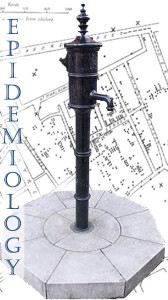Atif Kukaswadia writes in this review on Public Health Perspectives blog: Anyone who follows my writing knows that I’m a big proponent of using stories to talk about science. We’ve discussed how you can use science fiction teach science, zombies to talk about disease outbreaks, and my TEDx talk discussed using principles of storytelling in how we discuss science. So when I was asked to review (see disclaimer below) Dr  Alexandra Levitt’s new book “Deadly Outbreaks: How Medical Detectives Save Lives Threatened by Killer Pandemics, Exotic Viruses and Drug-Resistant Parasites,” I jumped on the opportunity.
Alexandra Levitt’s new book “Deadly Outbreaks: How Medical Detectives Save Lives Threatened by Killer Pandemics, Exotic Viruses and Drug-Resistant Parasites,” I jumped on the opportunity.
The CDC has a program known as the Epidemiologic Intelligence Services, where individuals trained in fields such as epidemiology, medicine, statistics and veterinary sciences come together to identify causes of diseases. For an overview of the EIS, check out this review of “Inside the Outbreaks” by Travis Saunders over at Obesity Panacea. The EIS was set up Alexander Langmuir, who has been profiled on the blog, and their work has been instrumental in learning about, and thus containing, disease outbreaks all over the world. Dr Levitt is well positioned to speak on these issues, having worked at the CDC since 1995, although it should be noted that this was written in her free time, not as part of her position at the CDC.
The book is comprised of 7 distinct chapters, each one covering a unique disease outbreak. In an almost “House-ian” style, the EIS agent will hear about an outbreak, go into an area, and then have to uncover what it is that is causing people to get sick, often with very little information to go on. I’m going to keep the details deliberately vague, as part of the joy of reading the book is guessing what is causing the outbreak, and following the train of thought of the investigators.
Another thing I really enjoyed about the book was how Dr Levitt deals with all important stakeholders, and talks about their history. One chapter deals with a Native American population that has undergone a disease outbreak, and does a great job explaining the history of these people. This is very pertinent information, as the problems of going into this community are a direct result of how these communities have been treated historically, and everything from the equipment you bring in, to the name of the disease, has to be cleared by elders and community leaders. The history of a group is something public health practitioners need to be aware of and sensitive to in order to work with these people to identify causes of disease, and this was illustrated well in this book.
Finally, at a more stylistic level, a conscious decision the author makes is to provide context for the characters. For example, in Chapter 1 the “protagonist” is eagerly anticipating her wedding, and at one point goes for dinner and discusses this with a colleague while talking about the case at hand. In a later chapter, the author describes Dr Stacy Holzbauer, a veterinarian, as someone whose “plan was to become a  large-animal veterianian, marry a cowboy, live on a ranch on the Great Plains, and raise cowboys,” a vivid and charming description. While she did become a veterinarian, she then pursued a MPH and now does brilliant public health work. This makes the characters that much more fleshed out and human, rather than being 2-dimensional and alien, a welcome respite from the socially awkward, comically inept, and often evil, scientist of television and film. At points I found this transition jarring, but it adds to the overall feel of the book, and I think helps the book connect with the general public.
large-animal veterianian, marry a cowboy, live on a ranch on the Great Plains, and raise cowboys,” a vivid and charming description. While she did become a veterinarian, she then pursued a MPH and now does brilliant public health work. This makes the characters that much more fleshed out and human, rather than being 2-dimensional and alien, a welcome respite from the socially awkward, comically inept, and often evil, scientist of television and film. At points I found this transition jarring, but it adds to the overall feel of the book, and I think helps the book connect with the general public.
And the general public, especially those with an interest in public health, is the target audience. I would recommend this book to those interested in learning more about public health, both from an infectious disease  standpoint, as well as from a practical, i.e. how do we actually investigate disease outbreaks, standpoint. It’s written for a lay audience, and avoids jargon and delving too far into statistics or biology, which makes it easy and straightforward to follow. If you’re considering pursuing an MPH and want to do “shoe leather epidemiology,” it’s a must read.
standpoint, as well as from a practical, i.e. how do we actually investigate disease outbreaks, standpoint. It’s written for a lay audience, and avoids jargon and delving too far into statistics or biology, which makes it easy and straightforward to follow. If you’re considering pursuing an MPH and want to do “shoe leather epidemiology,” it’s a must read.
